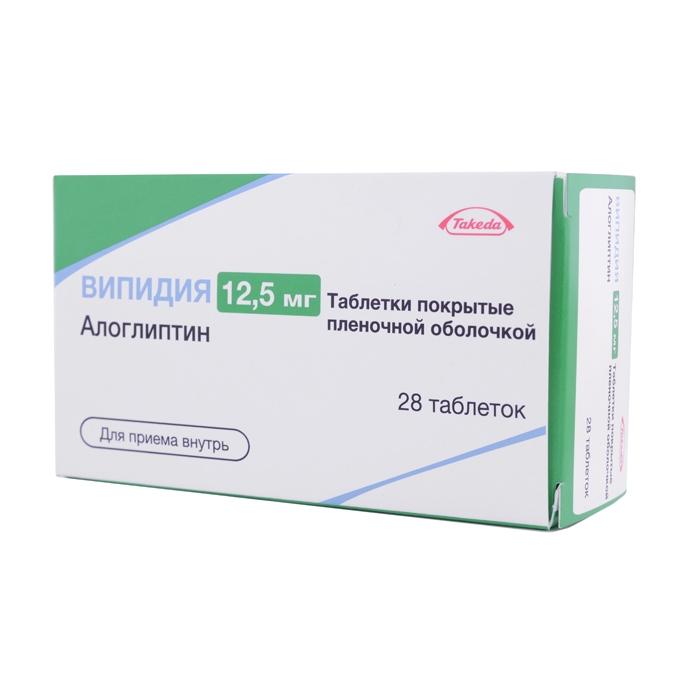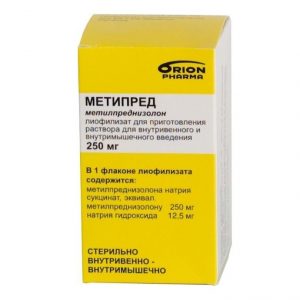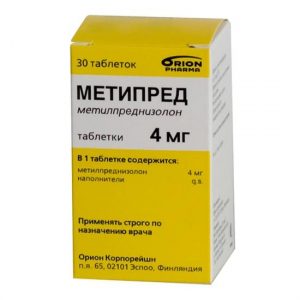Description
Release form
Film-coated tablets
Packing
28 pcs.
Pharmacological action of
Alogliptin is a potent and highly selective inhibitor of DPP-4. Its selectivity for DPP-4 is more than 10,000 times greater than its effect on other related enzymes, including DPP-8 and DPP-9. DPP-4 is the main enzyme involved in the rapid destruction of hormones of the incretin family: glucagon-like peptide-1 (GLP-1) and glucose-dependent insulinotropic polypeptide (HIP).
Hormones of the incretin family are secreted in the intestines, their concentration increases in response to food intake. GLP-1 and HIP increase insulin synthesis and its secretion by pancreatic beta cells. GLP-1 also inhibits glucagon secretion and reduces liver glucose production. Therefore, increasing the concentration of incretins, alogliptin increases the glucose-dependent secretion of insulin and decreases the secretion of glucagon with an increased concentration of glucose in the blood. In patients with type 2 diabetes mellitus with hyperglycemia, these changes in the secretion of insulin and glucagon lead to a decrease in the concentration of glycated hemoglobin HbA1c and a decrease in the concentration of glucose in blood plasma both on an empty stomach and postprandial glucose.
Indications
Type 2 diabetes mellitus for improving glycemic control with diet therapy and exercise inefficiency: adult
as monotherapy, in combination with other oral hypoglycemic agents or with insulin.
Pregnancy and lactation
No studies have been conducted on the use of alogliptin in pregnant women. Animal studies have not shown a direct or indirect negative effect of alogliptin on the reproductive system. However, as a precaution, the use of Vipidia during pregnancy is contraindicated.
There is no data on the penetration of alogliptin into human milk. Animal studies have shown that alogliptin passes into breast milk, so the risk of side effects in babies cannot be ruled out. In this regard, the use of the drug during breastfeeding is contraindicated.
Special instructions
Use with other hypoglycemic drugs
To reduce the risk of hypoglycemia, it is recommended to reduce the dose of sulfonylurea derivatives, insulin or a combination of pioglitazone (thiazolidinedione) with metformin while using it with Vipidia ®.
Unexplored combinations
The efficacy and safety of using Vipidia ® in combination with sodium-dependent glucose cotransporter inhibitors 2 or glucagon-like peptide analogues and in triple combination with metformin and sulfonylurea derivatives have not been studied.
Renal failure
Because patients with moderate renal insufficiency are required to carry out dose adjustment of Vipidia ®, it is recommended to evaluate renal function before and periodically during treatment.
Experience with alogliptin in patients on hemodialysis is limited. Vipidia ® should not be used in patients with severe renal failure, as well as in patients with end-stage chronic renal failure requiring hemodialysis. Alogliptin has not been studied in patients undergoing peritoneal dialysis.
Acute pancreatitis
The use of DPP-4 inhibitors is associated with a potential risk of developing acute pancreatitis. In a generalized analysis of 13 clinical studies of the use of alogliptin at a dose of 25 mg / day, 12.5 mg / day, the comparison drug and placebo, the incidence of acute pancreatitis was 2, 1, 1 or 0 cases per 1000 patient-years in each group, respectively. In a study of cardiovascular outcomes, the incidence of acute pancreatitis in patients treated with alogliptin or placebo was 3 and 2 cases per 1000 patient-years, respectively. Patients should be informed about the characteristic symptoms of acute pancreatitis: persistent severe pain in the abdomen, which can radiate to the back. If you suspect the development of acute pancreatitis, the drug Vipidia ® is stopped when the acute pancreatitis is confirmed, the drug is not renewed. There is no evidence of an increased risk of developing pancreatitis while taking Vipidia ® in patients with a history of pancreatitis. Therefore, when using the drug in patients with a history of pancreatitis, caution should be exercised.
Hepatic Insufficiency
Postmarketing reports of impaired liver function, including hepatic impairment when taking alogliptin, have been received. Their relationship with the use of the drug has not been established. However, patients should be carefully examined for possible abnormalities in liver function. If abnormalities in liver function are detected and an alternative etiology of their occurrence is not established, consideration should be given to discontinuing treatment with the drug.
Impact on the ability to drive vehicles and mechanisms
Vipidia ® does not have or has a slight effect on the ability to drive vehicles and mechanisms. However, the risk of hypoglycemia should be considered when using the drug in combination with other hypoglycemic drugs (sulfonylureas, insulin or combination therapy with pioglitazone and metformin) and caution when driving vehicles and mechanisms.
Composition
1 tablet 12.5 mg contains
Active ingredient:
alogliptin benzoate – 17 mg (in terms of alogliptin – 12.5 mg).
Excipients:
Core: mannitol 96.7 mg, microcrystalline cellulose 22.5 mg, hyprolose 4.5 mg, croscarmellose sodium 7.5 mg, magnesium stearate 1.8 mg.
Film coating: hypromellose 2910 5.34 mg, titanium dioxide 0.6 mg, dye iron oxide yellow 0.06 mg, macrogol-8000 trace amounts, gray ink F1 trace amounts of
Dosage and administration of
The drug is taken orally.
The recommended dose of Vipidia is 25 mg once daily as monotherapy or in addition to metformin, thiazolidinedione, sulfonylurea derivatives or insulin, or as a three-component combination with metformin, thiazolidinedione or insulin. The drug Vipidia can be taken regardless of the meal. Tablets should be swallowed whole without chewing, washed down with water.
If the patient has missed taking Vipidia, he should take the missed dose as soon as possible. It is unacceptable to take a double dose of Vipidia on the same day.
When prescribing Vipidia in addition to metformin or thiazolidinedione, the dose of the latter drugs should be left unchanged.
When combining Vipidia with a sulfonylurea derivative or insulin, it is advisable to reduce the dose of the latter to reduce the risk of hypoglycemia. In connection with the risk of hypoglycemia, caution should be exercised when prescribing a three-component combination of Vipidia with metformin and thiazolidinedione. In the case of hypoglycemia, it is possible to consider a decrease in the dose of metformin or thiazolidinedione. The efficacy and safety of alogliptin when taken in triple combination with metformin and a sulfonylurea derivative have not been studied.
Patients with renal failure
Patients with mild renal failure (creatinine clearance from> 50 to < 80 ml / min) dose adjustment of the drug Vipidia is not required. In patients with moderate renal failure (creatinine clearance from> 30 to <50 ml / min), the dose of Vipidia is 12.5 mg once a day. Alogliptin should not be used in patients with severe renal insufficiency and patients with end-stage renal failure requiring hemodialysis (creatinine clearance from patients with renal insufficiency is recommended to evaluate renal function before treatment with Vipidia and periodically during treatment. Patients with hepatic impairment insufficiency No dose adjustment of Vipidia is required in patients with mild to moderate hepatic insufficiency (from 5 to 9 points for Child-Pugh scale). The drug has not been studied in patients with severe liver failure (more than 9 points on the Child-Pugh scale), therefore, it should not be used in this group of patients. Patients over 65 years of age No dose adjustment is required for vipidia in patients over 65 years of age. Nevertheless, the dose of alogliptin should be especially carefully selected in connection with the potential possibility of decreased renal function in this group of patients. Side effects Disorders of the nervous system: Often: headache. Disorders of the gastrointestinal tract: Often: epigastric pain, gastroesophageal reflux disease. Frequency not found: acute pancreatitis. Disorders of the liver and biliary tract: Frequency not found: impaired liver function, including liver failure. Disorders of the skin and subcutaneous tissue: Often: itching, rash. Frequency not found: exfoliative skin diseases, including Stevens-Johnson syndrome, angioedema, urticaria. Infectious or parasitic diseases Often: upper respiratory tract infections, nasopharyngitis. Immune system disorders Frequency not found: hypersensitivity reactions, including anaphylactic reactions. Drug interactions Effect of other drugs on alogliptin Alogliptin is mainly excreted unchanged by the kidneys and is slightly metabolized by the cytochrome (CYP) P450 enzyme system. In studies on the interaction with other drugs, the following drugs did not have a clinically significant effect on the pharmacokinetics of alogliptin: gemfibrozil (a CYP2C8 / 9 inhibitor), fluconazole (a CYP2C9 inhibitor), ketoconazole (a CYP3A4 inhibitor), cyclosporine (a r-glyc inhibitor) β-glycosidases, digoxin, metformin, cimetidine, pioglitazone or atorvastatin. The effect of alogliptin on other drugs In vitro studies have shown that alogliptin does not inhibit or induce CYP 450 isoforms in concentrations achieved with alogliptin at a recommended dose of 25 mg. Interaction with CYP 450 isoforms is not expected and has not been identified. In vitro studies have shown that alogliptin is neither a substrate nor an inhibitor of OAT1, OATZ and OST2. In addition, clinical trial data do not indicate interaction with p-glycoprotein inhibitors or substrates. In clinical trials with other drugs, alogliptin did not have a clinically significant effect on the pharmacokinetics of the following drugs: caffeine, (R) – and (S) -varfarin, pioglitazone, glibenclamide, tolbutamide, dextromethorphan, atorvastatin, midazolamtronov, noron and ethinyl estradiol), digoxin, fexofenadine, metformin or cimetidine. Based on this data, alogliptin does not inhibit the isoenzymes of the cytochrome system CYP1A2, CYP3A4, CYP2D6, CYP2C9, p-glycoprotein and OCT2. Alogliptin had no effect on the prothrombin index or International Normalized Ratio (MHO) in healthy volunteers when taken with warfarin. The administration of alogliptin in combination with metformin, or pioglitazone (thiazolidinedione), or an -Glycosidase inhibitor, or glibenclamide (sulfonylurea derivative) did not show clinically significant pharmacokinetic interactions. overdose The maximum dose of alogliptin in clinical studies was 800 mg / day in healthy volunteers and 400 mg / day in patients with type 2 diabetes for 14 days. This is 32 and 16 times, respectively, higher than the recommended daily dose of 25 mg of alogliptin. There were no serious undesirable effects when taking the drug at these doses. Gastric lavage and symptomatic treatment may be recommended for overdose. Alogliptin is poorly dialysable. In clinical studies, only 7% of the dose was removed from the body during a 3-hour dialysis session. There are no data on the effectiveness of peritoneal dialysis alogliptin. Storage conditions Do not store above 25 ° C. Shelf life 3 years. Active ingredient Alogliptin Terms and conditions prescription dosage form tablets Possible product names Vipidia tablets 12.5 mg 28 pcs. Takeda GmbH, Japan



